Air of Authority - A History of RAF Organisation
 Forming
at Netheravon on 23 July 1915, No 21 moved across to France with its RE7s in
January 1916. It initially operated in the Army role, which involved
bombing and long range reconnaissance, but in August the demand for fighter
squadrons saw 21 re-equipping with BE12s for this role. However, due the
BE12s poor performance the squadron still continued to carry out bombing
operations and so in February 1917, it converted to the Corps reconnaissance
role with RE8s. It continued in this role until the end of the war ,
returning to Britain in February 1919 and disbanding on 1 October of that year.
Forming
at Netheravon on 23 July 1915, No 21 moved across to France with its RE7s in
January 1916. It initially operated in the Army role, which involved
bombing and long range reconnaissance, but in August the demand for fighter
squadrons saw 21 re-equipping with BE12s for this role. However, due the
BE12s poor performance the squadron still continued to carry out bombing
operations and so in February 1917, it converted to the Corps reconnaissance
role with RE8s. It continued in this role until the end of the war ,
returning to Britain in February 1919 and disbanding on 1 October of that year.
It was 3 December 1935 before the squadron reformed, which happened at Bircham Newton. The squadron was a light bomber unit equipped with Hinds, which it replaced with Blenheims in August 1938. In the early part of WW2, the squadron operated against targets in Holland and Belgium but in June 1940, it moved to Lossiemouth, from where it undertook anti-shipping operations. It returned to East Anglia in October but in December was sent to Malta, where it carried out anti-shipping missions until disbanding on 14 March 1942.
At Bodney on the same day, a new No 21 formed, taking over the Blenheims of No 82 Squadron. Two months later Venturas arrived followed by a lengthy work-up delaying the squadron's first operation with the new aircraft taking place on 6 December 1942. This involved 17 aircraft being sent on the famous daylight attack on the Philips Electronics factory at Eindhoven. It was a case of being equipped with an unsuitable type again and in September 1943 the squadron re-equipped with the Mosquito. At the same time it began to operate in the night bombing role as well as carrying out daylight missions occasionally. As Allied troops moved towards Germany many squadrons moved onto the continent and No 21 was one of these in February 1945, from where it continued to undertake intruder operations. It remained in Germany after the war, disbanding at Gutersloh on7 November 1947.
It rejoined the 'Order of Battle' on 21 September 1953 as a Canberra squadron at Scampton. It moved to Waddington in 1955, where it disbanded on 30 June 1957. When No 542 Squadron had finished carrying out its duties in Australia as part of Britain's nuclear testing programme, it was re-numbered No 21 on 1 October 1958, but this period of existence was short-lived as it disbanded at Upwood on 15 January 1959.
Four months later, on 1 May, it was revived at Benson in the light transport role, equipped with Twin Pioneers. It moved out to Kenya the following September, where it stayed until June 1965 when it moved north to Aden. It continued to operate in support of Army operations in the Radfan until disbanding on 15 September 1967. No 21's final incarnations began on 3 February 1969 when the Western Communications Squadron was redesignated at Andover, being finally disbanded on 31 March 1976. At the time of writing (February 2002), the squadron is dormant.
| Standards | Battle Honours* |
| None awarded |
Somme, 1916: Western Front, 1916-18: Messines, 1917: Arras, 1917: Ypres, 1917: Cambrai, 1917: Amiens: Somme, 1918: Channel & North Sea, 1939-41: France & Low Countries, 1940: Dunkirk: German Ports, 1941: Fortress Europe, 1940-45: Biscay Ports, 1941: Biscay 1941: Malta, 1942: Mediterranean, 1942: Normandy, 1944: France & Germany, 1944-45: |
Squadron Codes used: -
| JP | Apr 1939 - Sep 1939 |
| YH | Sep 1939 - Nov 1947 |
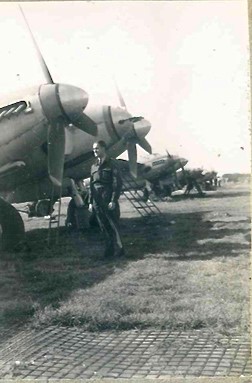
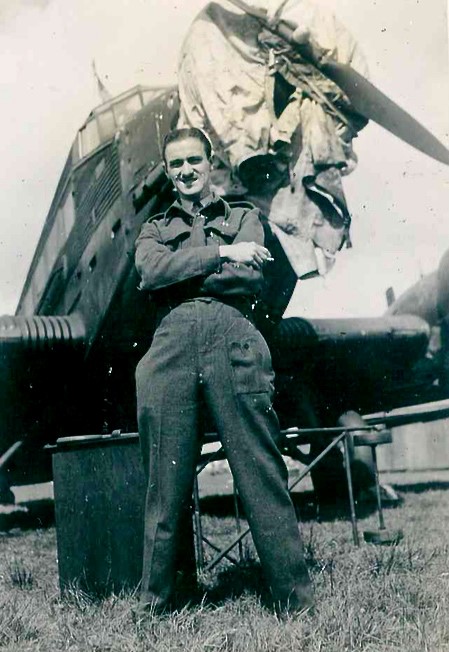 |
| Alan Jenkins |
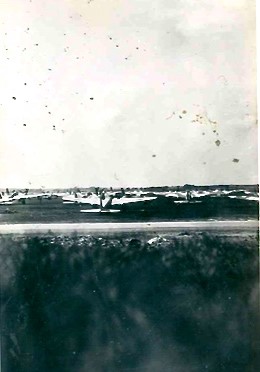
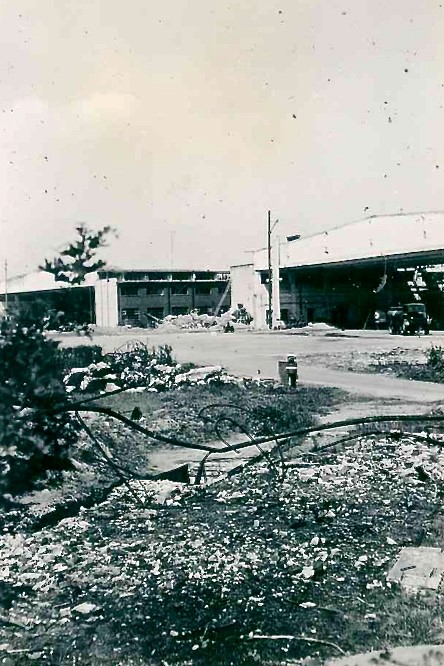 |
| Left - Mosquitos of No 21 Squadron, Right - Hangers probably at RAF Gutersloh |
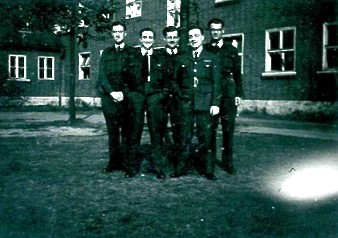
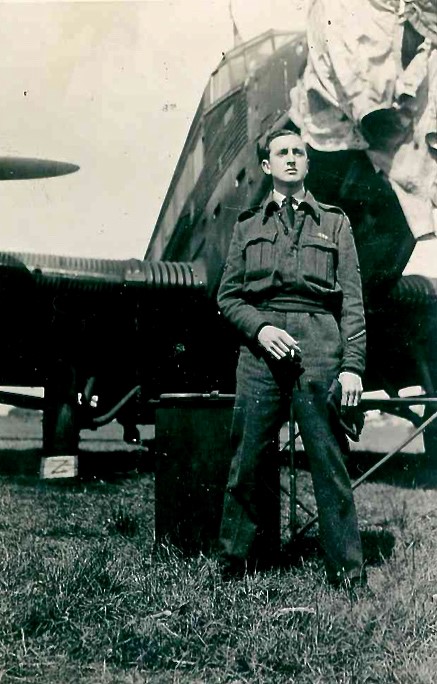 |
|
Left - Block 35 (where?) - Glyn Cleaves 2nd from left Right - Glyn Cleaves |
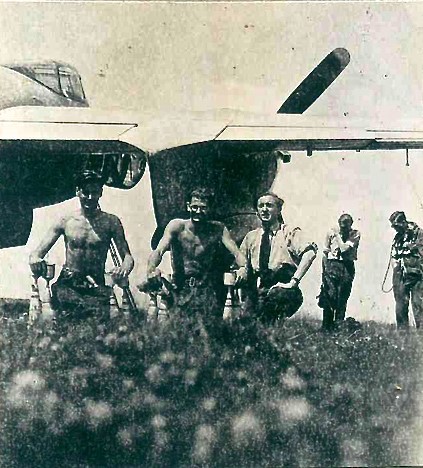
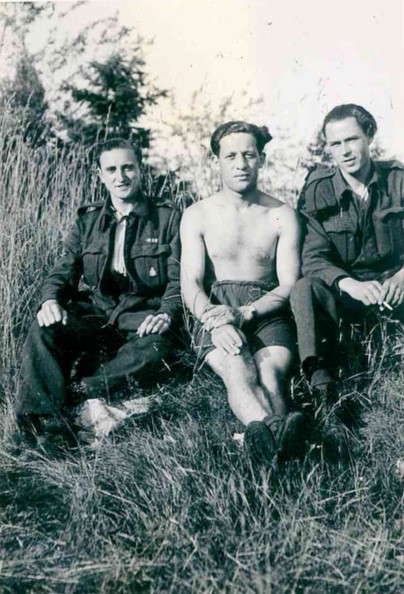 |
| Left - Glyn Cleaves 3rd from left. Right - Glyn Cleaves left |
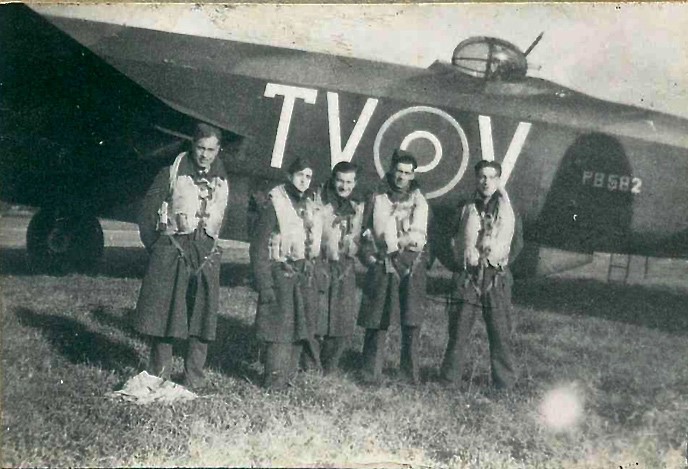 |
| Leaving for Sylt. Glyn Cleaves 2nd from left The photos above are courtesy of Stephen Lyons |
[Aircraft & Markings | Personnel, aircraft and locations | Commanding Officers]
 The use of the symbol 'pi' is said to have originated from the
fact that during part of WW1, No 22 was part of No 7 Wing and that when taking
off in a certain direction aircraft of No 22 flew over the HQ of No 7
Wing. This lead to the use of 'pi' because 'pi' can be expressed
mathematically as "22 over 7". No 22 arrived in France equipped
with FE2bs on 1 April 1916 having been formed at Gosport on 1 September the
previous year. It operated in the Army Reconnaissance role until July 1917
when it converted to the Bristol F2b and the fighter-reconnaissance role.
Becoming part of the Army of Occupation it returned to Britain in September
1919, disbanding at Ford on 31 December 1919.
The use of the symbol 'pi' is said to have originated from the
fact that during part of WW1, No 22 was part of No 7 Wing and that when taking
off in a certain direction aircraft of No 22 flew over the HQ of No 7
Wing. This lead to the use of 'pi' because 'pi' can be expressed
mathematically as "22 over 7". No 22 arrived in France equipped
with FE2bs on 1 April 1916 having been formed at Gosport on 1 September the
previous year. It operated in the Army Reconnaissance role until July 1917
when it converted to the Bristol F2b and the fighter-reconnaissance role.
Becoming part of the Army of Occupation it returned to Britain in September
1919, disbanding at Ford on 31 December 1919.
It was reformed on 24 July 1923 as part of the Aeroplane and Armament Experimental Establishment at Martlesham Heath, where it undertook trials on various types prior to their acceptance or otherwise into service. When it was redesignated the Performance Testing Squadron on 1 May 1934 a new No 22 came into being at Donibristle. It was now in the Torpedo-bomber role, equipped with Vildebeests, which it took with it to Malta in October 1935, during the Abyssinian Crisis. Returning to the UK in August 1936 and moving to Thorney Island in 1938, it was November 1939 before replacements for the Vildebeests began to arrive. These were in the form of the Bristol Beaufort, with which the squadron carried out its first operation on 15 April 1940.
At one point the squadron also trained Maryland crews ('C' Flight) who later joined No 431 Flight in Malta. Operations continued against coastal targets and shipping until March 1942 when the squadron began its move overseas, arriving in Ceylon on 28 April 1942. After an attempt by the Japanese to attack Ceylon further expected attacks did not materialise and No 22 found itself carrying out escort and anti-submarine patrols. Re-equipment with Beaufighters occurred in June 1944 and from December, that year it moved to Burma and began ground attack and ASR missions, disbanding on 30 September 1945.
It reformed again in the Far East on 1 may 1946 at Seletar when No 89 Squadron was redesignated but on 15 August it disbanded yet again. There then followed a eight and a half year break until 15 February 1955 when it reformed at Thorney Island as a Search and Rescue Helicopter unit, however, during this period (11 December 1949 - 20 December 1954) it was linked to No 29 Squadron as a way of keeping that number alive. As such it has operated detached flights at various locations around the British Isles until the present day and has been equipped with the Sycamore HC Mk 14s (1955), Whirlwind HAR Mk 2 (1955 - 1963), Whirlwind HAR Mk 10 (1962 - 1981), Wessex HAR Mk 2 (1976 - 1997) and Sea King HAR Mk 3/3A (1997 - 2015). In July 2015 the last SAR flight was carried out by 'C' Flight at RAF Valley with UK SAR responsibility being transferred to the Coastguard and Maritime Agency.
It reformed at RAF Benson on 14 May 2020, as the Operational Evaluation Unit for Joint Helicopter Command.
| Standards | Battle Honours* |
| Award
of Standard
originally announced on 15 Jan 1952, effective from 1 Apr 1951 but presented:-
1st - 20 October 1960 2nd - 15 March 1978 ACM Sir David Evans. |
Western Front, 1916-1918: Somme, 1916: Ypres, 1917: Cambrai, 1917: Somme, 1918: Lys: Amiens: Hindenburg Line: Channel & North Sea, 1939-1941: France & Low Countries, 1940: Invasion Ports, 1940: Biscay Ports, 1940-1941: Mediterranean, 1942: Eastern Waters, 1942-1945: Burma, 1944-1945: |
Squadron Codes used: -
| VR | Apr 1939 - Sep 1939 |
| OA | Sep 1939 - Nov 1944 |
[Aircraft & Markings | Personnel, aircraft and locations | Commanding Officers]
No 22 Squadron Association: - e-mail: paulmartin@argonet.co.uk
No 23 formed originally at Gosport on 1 September 1915. Whilst training it also acted in the air defence role for London but in March 1916, it took its FE2bs to France. In February 1917 it re-equipped with SPADs undertaking ground attack missions, which continued after re-equipping with Dolphins in early 1918. Along with many of its contemporaries it returned to Britain in March 1919 and disbanded on 31 December at Waddington. The squadron rejoined the fighter defences of the UK on 1 July 1925 at Henlow, equipped with Sopwith Snipes. Unlike other squadrons during the inter-war period it changed locations a number of times, Kenley (February 1927), Biggin Hill (September 1932) and Northolt (December 1936) before arriving at Wittering in May 1938. It successively re-equipped with Gamecocks, Bulldogs, Hart and Demons and then in December 1938 it became a twin engined fighter unit when it received Blenheim If's. On the outbreak of war the squadron adopted a night fighter role but in December 1940 it started night intruder operations against German airfields.
It continued in the night intruder role for the whole of WW2, re-equipping with Havocs in March 1941 and Mosquitos in July 1942, which it flew until the end of the war. However, it did not restrict its operational areas to Northern Europe, as between December 1942 and May 1944 it flew out of Malta from where it operated over Sardinia, Sicily, Tunisia and Southern France. Following its return to the UK it joined No 100 Group, where it was now operating in support of Bomber Command raids, eventually disbanding on 25 September 1945.
From 11 September 1946 until 31October 1975, the squadron operated continuously in the night/all-weather fighter role. Initially equipped with Mosquitos again, Vampire NF Mk 10s arrived in September 1951 followed by Venom NF Mk 2s (November 1953), Venom NF Mk 3s (October 1955), three versions of the Javelin (FAW Mk 4 - April 1957, FAW Mk 7 - April 1959 and FAW Mk 9 - April 1960) and finally Lightnings (F Mk 3 - August 1964, F Mk 6 - May 1967). From 11 February 1949 to 14 September 1951, No 151 Squadron was linked to it, in an attempt to keep defunct squadron numbers active.
On 8 October 1975 No 23 (Designate) Squadron had begun training on the Phantom FGR Mk 2 at Coningsby and it took over the now defunct numberplate of No 23 on 1 December 1975. It moved to Wattisham in February 1976 remaining there until disbandment on 30 Mar 1983. Following the Falklands war a detachment of Phantoms had been provided by the home based units of Strike Command and on 30 March 1983, this was being provided by an element of No 29 Squadron, but on that day the element was redesignated 23 Squadron. On 21 April 1986 it moved from Port Stanley to the newly opened Mount Pleasant airfield where it was disbanded on 31 October 1988 on being redesignated No 1435 Flight .
The following day it reformed at Leeming as a Tornado F Mk 3 unit but was disbanded again on 26 February 1994. Its next incarnation begun on 1 April 1996 when the Sentry Training Squadron at Waddington was redesignated, and although it still retained the OCU role, its crews also carried out operational missions, however, on 2 October 2009 the squadron disbanded once again. In January 2021, the squadron was reformed to undertake 'Space' operations.
| Standards | Battle Honours* |
| Award
of Standard
originally announced on 15 Jan 1952, effective from 1 Apr 1951 but presented:-
1st - 28 June 1957 2nd - 2 February 1987 AM Sir Anthony Skingsley |
Home Defence, 1916:
Western Front, 1916-1918: Somme, 1916: Arras: Ypres, 1917:
Somme, 1918: Channel & North Sea, 1939-1940: Fortress Europe, 1940-1944:
North Africa, 1943: Sicily, 1943:
Italy, 1943-1944:
Anzio & Nettuno: France & Germany, 1944-1945: Ruhr, 1944-1945:
Iraq 2003: |
Squadron Codes used: -
| MS | Sep 1938 - Sep 1939 |
| YP | Sep 1939 - May 1945, Sep 1946 - Apr 1951 |
| E | Carried on Tornados |
[Aircraft & Markings | Personnel, aircraft and locations | Commanding Officers]
No 23 Squadron Association: - e-mail: historian@23sqn-association.co.uk
 The first squadron in the RFC to operate the DH2 fighter, No 24 was formed on 1
September 1915 at Hounslow Heath, moving to France in February 1916. The
'pusher' design of the DH2 meant that its fixed forward firing machine gun was
unobstructed by a propeller and it therefore played a large part in defeating
the 'Fokker Scourge'. DH5s arrived in May 1917 and the following December
these were replaced by SE5As, which it operated until the end of the war and
afterwards until it returned to the UK in February 1919, disbanding a year
later.
The first squadron in the RFC to operate the DH2 fighter, No 24 was formed on 1
September 1915 at Hounslow Heath, moving to France in February 1916. The
'pusher' design of the DH2 meant that its fixed forward firing machine gun was
unobstructed by a propeller and it therefore played a large part in defeating
the 'Fokker Scourge'. DH5s arrived in May 1917 and the following December
these were replaced by SE5As, which it operated until the end of the war and
afterwards until it returned to the UK in February 1919, disbanding a year
later.
When it reformed at Kenley on 1 April 1920, it was as a communications and training squadron. During the next few years it operated a wide variety of types carrying government and senior RAF personnel as well as government despatches during the General Strike of 1926. It also carried refresher flying course for officers returning to squadrons following staff appointments as well as providing facilities for those in staff appointments 'to keep their hand in' and maintain their flying pay. In 1927 the squadron moved to Northolt and in 1933 to Hendon, where it remained until 1946.
During the early part of the war its operations were mainly centred on the UK, but in April 1942 it began to fly to Gibraltar and later Malta. It was transferred from Fighter Command to No 44 Group on 25 April 1942. Dakotas arrived in April 1943 and in May it received its first York for carrying VIPs. As its overseas commitments grew, it was decided to transfer its short range communications types to No 512 Squadron and this occurred in August 1943. The Yorks left in October 1944, leaving just the Dakotas and some Ansons.
Post war it remained at Hendon until February 1946 when it moved to Bassingbourn, where it acquired the Yorks and Lancaster of no 1359 (VIP) Flight. On 20 April 1947, the squadron was named 'Commonwealth', being tasked with conducting VIP (Service and Civilian) flights for which its establishment was amended to include five RAAF, three SAAF and two RNZAF crews. By 1950 had standardised on the York, which it retained until December 1951, although Valettas arrived in November 1950 and Hastings in December, when the Valettas left, continuing to operate to Hastings until January 1968. The squadron had moved from Bassingbourn to Waterbeach in 1949 and subsequently to Lyneham (1950), Topcliffe (1951), Abingdon (1953) and finally Colerne in 1957.
In January 1968, the squadron received its first of the American built Lockheed Hercules C Mk 1s and a month later moved for the last time back to Lyneham, where it flew all four versions of the Hercules, although the aircraft were pooled centrally and allocated to squadrons as required. On 1 July 2011, together with the rest of the Hercules fleet the squadron moved to a new base at RAF Brize Norton and in 2013 became the Air Mobility Operational Conversion Unit.
| Standards | Battle Honours* |
| Award of Standard originally announced on 7 Sep 1943,
effective from 1 Apr 1943 but
presented:- 1st - 4 March 1954 2nd - 15 September 1981 HRH The Princess Anne. |
Western Front, 1916-1918:
Somme, 1916: Somme,
1918: Amiens: Hindenburg Line: France & Low Countries, 1939-1940:
Malta, 1942: North Africa, 1942-1943: Italy,
1943-1944: Burma, 1944-1945:
Gulf, 1991: |
Squadron Codes used: -
| ZK | Apr 1939 - Sep 1939, Apr 1941 - 1943 (duplicated with No 25 Sqn) |
| NQ | 1943 - 1946 |
[Aircraft & Markings | Personnel, aircraft and locations | Commanding Officers]
 No
25 Squadron arrived in France in February 1916, having been formed from a
nucleus of No 6 Reserve Squadron on 25 September 1915. It initially flew
fighter-reconnaissance mission equipped with FE2bs until June 1917, when it
re-equipped with DH4s and changed over to the day-bomber role. Planned
re-equipment with theDH9A never materialised and so it took its DH4s to
Germany at the end of the war. It returned to the UK in September 1919
and disbanded at Scopwick on 31 January 1920.
No
25 Squadron arrived in France in February 1916, having been formed from a
nucleus of No 6 Reserve Squadron on 25 September 1915. It initially flew
fighter-reconnaissance mission equipped with FE2bs until June 1917, when it
re-equipped with DH4s and changed over to the day-bomber role. Planned
re-equipment with theDH9A never materialised and so it took its DH4s to
Germany at the end of the war. It returned to the UK in September 1919
and disbanded at Scopwick on 31 January 1920.
The following day it reformed at Hawkinge as a day-fight unit equipped with Snipes. From September 1922 until October 1923, it was detached to Turkey during the Chanak Crisis. Grebes replaced the Snipes in October 1924, with Siskins arriving in may 1929 and Furies in February 1932. From October 1937 the squadron converted to the two-seater fighter role when it re-equipped with Demons, but single seaters returned in Jun 1938 with the arrival of Gladiators.
This was another short-lived re-equipment for in December 1938, Blenheim IFs arrived and it became a night fighter squadron. Beaufighters began to arrive in October 1940 but it was January 1941 before the last Blenheim had gone. The first Mosquitos were received in August 1942 and as targets over Britain grew fewer No 25 began to carry out intruder operations over German airfields. It also started bomber support missions of the type that would be later used by squadrons of No 100 Group. During 1944, it was involved in night interceptions of V-1 flying bombs after which it returned to intruder and fighter operations over Northern Europe.
Retained as part of the post-war air force, No 25 continued to operate the Mosquito until November 1951, when Vampires finally replaced them, conversion having begun in February 1951. The Vampires were replace d by Meteor NF Mk 12s and 14s in March 1954 and in 1957 the squadron moved from West Malling to Tangmere, where it disbanded on 23 June 1958.
However, it was not dormant for long because on 1 July 1958 it was reformed by re-numbering No 153 Squadron at Waterbeach again equipped with Meteor night fighters. Javelin FAW Mk 7s arrived in March 1959 and FAW Mk 9s in December of the same year, the squadron operating both models until January 1961 when the 7s were retired. Shortly afterwards the squadron moved north to Leuchars, where the squadron disbanded again on 30 November 1962.
The following day the squadron reformed but it was now equipped with the Bloodhound Surface-to-Air missile at North Coates. In 1970 the squadron took its missiles to Germany and based at Bruggen it operated detachments to cover the other two 'Clutch' airfields at Laarbruch and Wildenrath. In 1983 it returned to Wyton and again operated detachments, this time at Barkston Heath and Wattisham. All these sites were absorbed into No 85 Squadron at West Raynham on 1 October 1989. The same day the numberplate was transferred to a Tornado F Mk 3 unit forming at Leeming. The new No 25 became operational on 1 January 1990 and remained so for the next 18 years until disbanding on 4 April 2008.
| Standards | Battle Honours* |
| Award of Standard originally
announced on 7
Sep 1943, effective from 1 Apr 1943 but presented:- 1st - 21 June 1954 2nd - 15 May 1984 ACM Sir Thomas Kennedy. |
Home Defence, 1916: Western Front, 1916-1918: Somme, 1916: Arras: Ypres, 1917: Cambrai, 1917: Somme, 1918: Lys: Hindenburg Line: Channel & North Sea, 1939-1941: Battle of Britain, 1940: Fortress Europe, 1943-1944: Home Defence, 1940-1945: France & Germany, 1944-1945 |
Squadron Codes used: -
| RX | Dec 1938 - Sep 1939 |
| ZK | Sep 1939 - Apr 1951 (duplicated with No 24 Sqn) |
| FA - FZ | Carried on Tornados |
|
|
|
Gloster Grebes of No 25 Squadron Photo from the collection of David Lloyd, courtesy of his son Sampson |
[Aircraft & Markings | Personnel, aircraft and locations | Commanding Officers]
No 25 squadron Association: - Membership Secretary: email peter.r.k.williams@tesco.net
email: 25squadron@imtex.com
*Honours in Black are those the squadron has a been granted the right to emblazon on the Squadron Standard, but does not do so.
Honours in Red are those actually emblazoned on the Squadron Standard
Honours in Blue are those the squadron has not been granted the right to emblazon on the Squadron Standard
Squadron badges on this page are courtesy of Dave Clifford
Badges of squadrons marked # have been produced by Mary Denton on behalf of the RAF Heraldry Trust and are displayed on this page with the permission of the RAFHT. Mary Denton and the RAFHT have probably completed half of the 'official' badges authorised but are still looking for sponsorship for the remaining badges. The work continues and details can be found on their website.
© Crown Copyright is reproduced with the permission of the Directorate of Intellectual Property Rights
This entry was last updated on 11/07/25©
![]() Organisational
Index
Organisational
Index ![]()